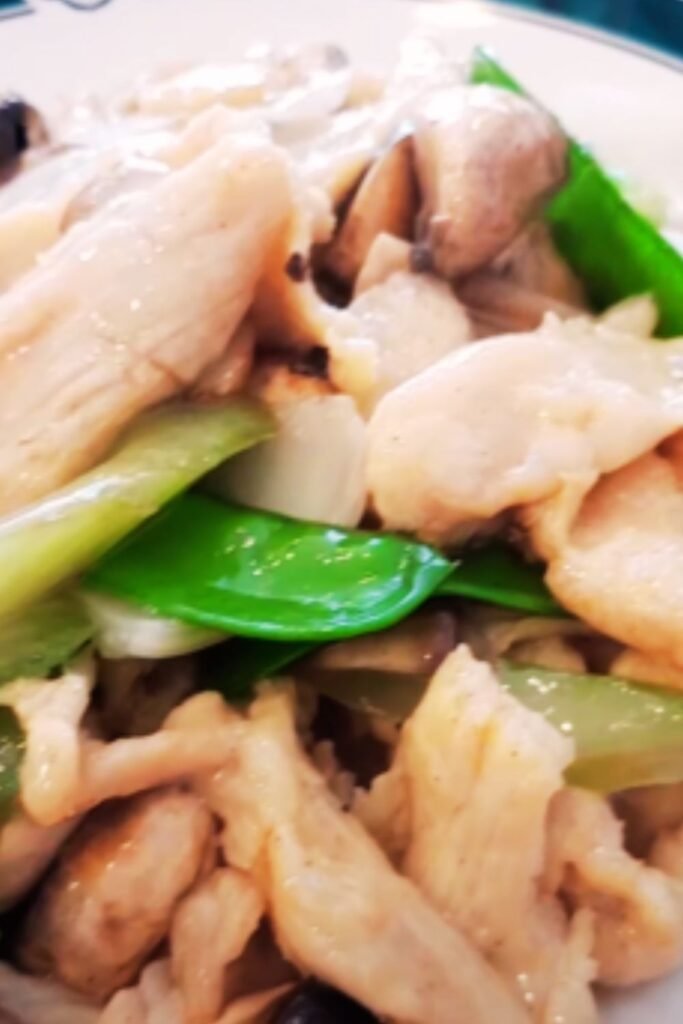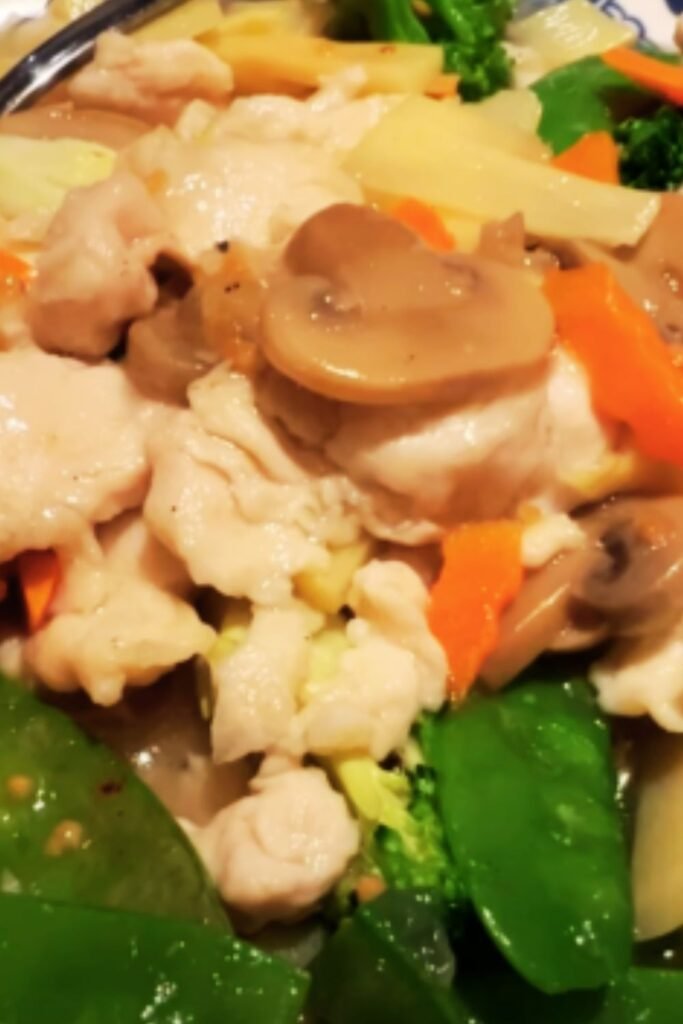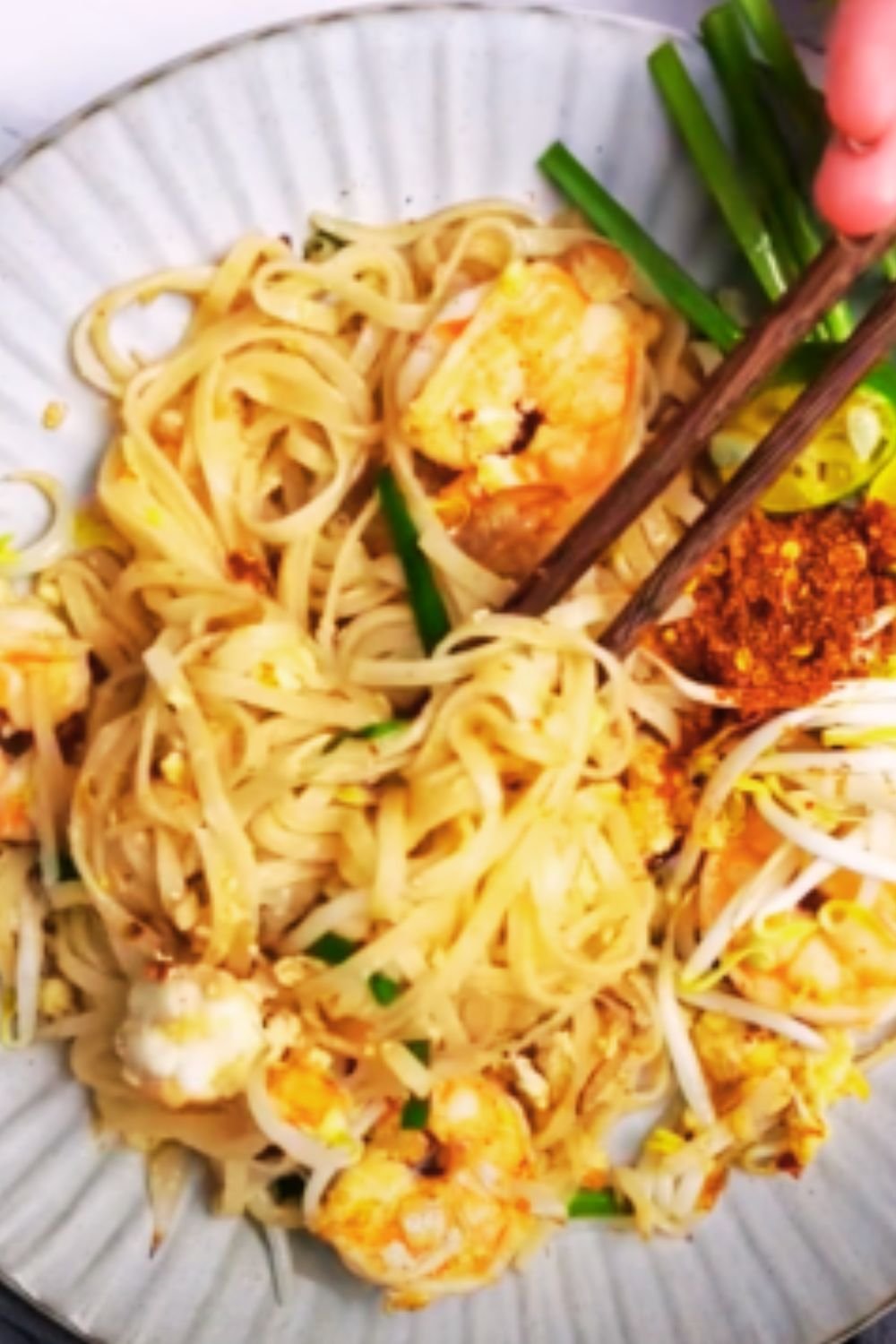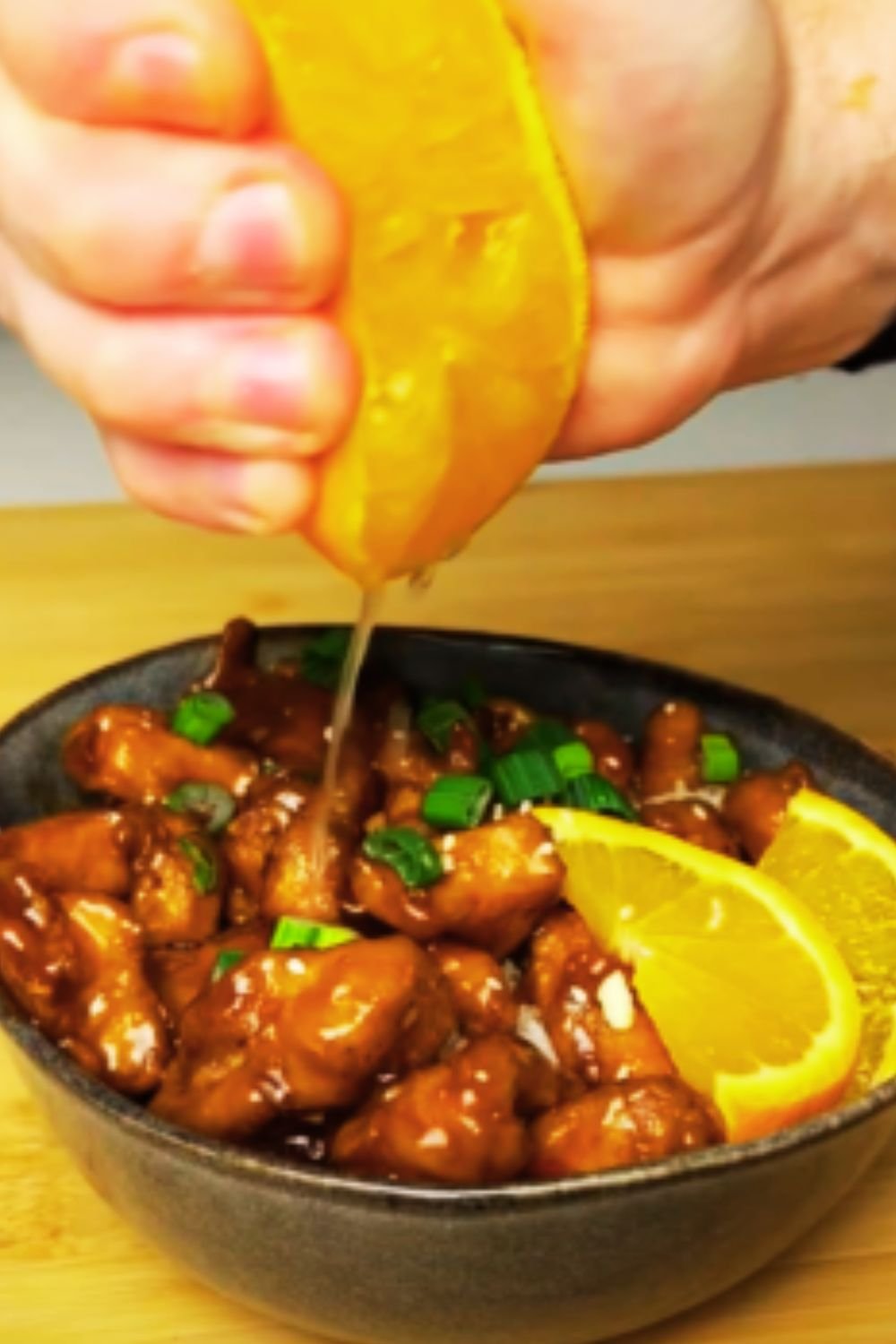Have you ever found yourself craving the comforting flavors of Chinese takeout but dreading the greasy aftermath? I’ve been there too many times to count. That’s why I’m thrilled to share my foolproof recipe for Moo Goo Gai Pan that’s not only quick and easy but also healthier than your typical restaurant version.
As someone who’s spent years perfecting home versions of takeout classics, I can confidently say this Moo Goo Gai Pan recipe hits all the right notes: tender chicken, crisp vegetables, and a velvety sauce that brings everything together in perfect harmony. The best part? You can whip it up in under 30 minutes with ingredients you probably already have in your pantry.
What is Moo Goo Gai Pan?
Before diving into the recipe, let’s take a moment to understand what Moo Goo Gai Pan actually is. The name itself tells us a lot about the dish:
Moo Goo : Cantonese term for button mushrooms
Gai : Chicken
Pan : Slices
So essentially, Moo Goo Gai Pan translates to “mushroom chicken slices.” While the traditional Cantonese version focuses primarily on chicken and mushrooms, the Americanized version we’re most familiar with incorporates a variety of vegetables, making it a well-balanced, nutritious meal.
The History Behind the Dish
Moo Goo Gai Pan originated in Guangdong province in southern China. When Chinese immigrants brought their culinary traditions to America in the 19th century, they adapted their recipes to local ingredients and tastes. The version we enjoy today is a perfect example of this culinary evolution – maintaining the essence of traditional Chinese cooking techniques while embracing a broader array of vegetables and flavors that appeal to American palates.
I find it fascinating how dishes transform as they travel across cultures, and Moo Goo Gai Pan exemplifies this beautiful culinary adaptation. The American version typically includes snow peas, water chestnuts, bamboo shoots, and sometimes carrots or broccoli – creating a colorful medley that’s as pleasing to the eye as it is to the palate.
Key Ingredients Breakdown
Let’s take a closer look at the star players in this dish:
Chicken Breast : The protein foundation of our dish. I recommend using boneless, skinless chicken breast for a leaner option. The velveting technique (which we’ll discuss shortly) ensures it stays tender and juicy.
Button Mushrooms : The “moo goo” in our recipe! These provide an earthy flavor and meaty texture that complements the chicken beautifully.
Bamboo Shoots : These add a distinctive crunch and subtle flavor that’s characteristic of many Chinese dishes.
Water Chestnuts : Perhaps my favorite ingredient for the incredible textural contrast they provide – crisp, refreshing, and slightly sweet.
Snow Peas : These bright green pods add color, crunch, and a touch of sweetness to balance the savory elements.
Chinese Cabbage : Adds volume and absorbs the flavors of the sauce wonderfully.
Sauce Components : A harmonious blend of chicken broth, oyster sauce, soy sauce, rice wine, and aromatics that ties everything together.

Special Techniques: The Secret to Restaurant-Quality Results
Velveting the Chicken
If you’ve ever wondered how Chinese restaurants achieve that incredibly tender, silky chicken texture, the answer lies in a technique called “velveting.” This is a critical step that many home cooks skip, but it makes all the difference in creating an authentic Moo Goo Gai Pan.
Here’s how I do it:
- Slice chicken breast against the grain into thin pieces
- Create a marinade of egg white, cornstarch, and a small amount of rice wine
- Coat the chicken pieces thoroughly
- Let them sit for at least 15 minutes (though 30 minutes is ideal)
- Briefly blanch in hot oil or water before stir-frying
This process creates a protective coating that seals in moisture, resulting in incredibly tender chicken that rivals any restaurant version.
The Art of the Quick Stir-Fry
Another crucial element is mastering the quick stir-fry technique. The key principles I always follow are:
- Prepare all ingredients before heating the wok
- Use high heat to achieve “wok hei” (the distinctive smoky flavor)
- Keep ingredients moving constantly
- Cook vegetables in order of density (harder vegetables first)
- Add sauce ingredients at the final stage
When executed properly, this method preserves the crispness of vegetables while allowing the flavors to meld perfectly.
Complete Recipe
Now that we understand the foundations, let’s put everything together in a comprehensive recipe.
Ingredients
For the Chicken Marinade (Velveting Mixture):
- 1 pound boneless, skinless chicken breast, thinly sliced
- 1 egg white
- 1 tablespoon cornstarch
- 1 tablespoon rice wine (or dry sherry)
- ¼ teaspoon salt
For the Sauce:
- ½ cup chicken broth
- 2 tablespoons oyster sauce
- 1 tablespoon light soy sauce
- 1 teaspoon sugar
- 1 teaspoon sesame oil
- 2 teaspoons cornstarch
- 1 tablespoon water (for cornstarch slurry)
For the Stir-Fry:
- 3 tablespoons vegetable oil (divided)
- 2 cups button mushrooms, sliced
- 1 can (8 oz) bamboo shoots, drained and sliced
- 1 can (8 oz) water chestnuts, drained and sliced
- 1 cup snow peas, ends trimmed
- 2 cups Chinese cabbage, chopped
- 2 cloves garlic, minced
- 1-inch piece ginger, julienned
- 2 green onions, cut into 1-inch pieces
Nutritional Information
Before we dive into the preparation, let’s take a look at the nutritional profile of this dish (approximate values per serving, assuming 4 servings total):
| Nutrient | Amount | % Daily Value |
|---|---|---|
| Calories | 285 | – |
| Protein | 27g | 54% |
| Carbohydrates | 16g | 5% |
| Dietary Fiber | 4g | 16% |
| Sugars | 3g | – |
| Fat | 13g | 20% |
| Saturated Fat | 2g | 10% |
| Sodium | 620mg | 26% |
| Potassium | 740mg | 21% |
| Vitamin A | – | 15% |
| Vitamin C | – | 45% |
| Calcium | – | 6% |
| Iron | – | 12% |
As you can see, this dish offers an excellent balance of macronutrients with particularly impressive protein content and moderate carbohydrates, making it a fantastic option for those monitoring their carb intake.
Step-by-Step Instructions
Preparation Phase
- Velvet the Chicken:
- In a medium bowl, whisk together egg white, cornstarch, rice wine, and salt until smooth
- Add chicken slices and mix until evenly coated
- Allow to marinate for 15-30 minutes in the refrigerator
- Prepare the Sauce:
- Combine chicken broth, oyster sauce, soy sauce, sugar, and sesame oil in a bowl
- In a separate small bowl, mix cornstarch and water to create a slurry
- Set both mixtures aside
- Prepare Vegetables:
- Clean and slice mushrooms
- Drain and rinse bamboo shoots and water chestnuts
- Trim snow peas
- Chop Chinese cabbage
- Mince garlic and julienne ginger
- Cut green onions
Cooking Phase
- Blanch the Velveted Chicken:
- Heat 2 tablespoons of oil in a wok or large skillet over high heat
- When oil is hot but not smoking, add marinated chicken pieces
- Quickly stir-fry for about 1-2 minutes until the outside turns white but chicken is not fully cooked
- Remove chicken and set aside on a plate
- Stir-Fry Vegetables:
- Return wok to high heat and add remaining tablespoon of oil
- Add garlic and ginger, stir-frying for 10 seconds until fragrant
- Add mushrooms and stir-fry for 1 minute
- Add bamboo shoots and water chestnuts, stir-frying for another minute
- Add snow peas and Chinese cabbage, stir-frying for 1-2 minutes until cabbage begins to wilt
- Combine and Finish:
- Return the partially cooked chicken to the wok
- Pour in the sauce mixture and bring to a simmer
- Give the cornstarch slurry a quick stir and pour it into the wok
- Stir constantly until the sauce thickens (about 30 seconds)
- Add green onions and stir to combine
- Remove from heat once sauce reaches desired consistency

Serving Suggestions
I love serving Moo Goo Gai Pan with steamed white rice, which provides the perfect canvas for soaking up the delicious sauce. For a lower-carb option, cauliflower rice works beautifully as well.
For a complete Chinese-inspired feast, consider pairing with:
- Hot and Sour Soup as a starter
- Spring rolls or dumplings as a side
- Fresh fruit like oranges or pineapple for dessert
- Jasmine tea to cleanse the palate
Storage and Reheating Tips
One of the things I appreciate most about this dish is how well it holds up as leftovers. Here’s how I handle storage and reheating:
Storage:
- Allow the dish to cool completely before refrigerating
- Store in an airtight container for up to 3 days
- Do not freeze (the vegetables will lose their crisp texture)
Reheating:
- For best results, reheat in a wok or skillet over medium heat
- Add a splash of water or chicken broth to revitalize the sauce
- Stir frequently until just heated through (about 3-4 minutes)
- Avoid microwave reheating if possible as it can make the chicken rubbery
Variations to Try
While the classic recipe is delightful on its own, I often experiment with these variations:
Protein Swaps
- Swap chicken for shrimp for a seafood version
- Use thinly sliced beef for a heartier dish
- Try firm tofu for a vegetarian alternative (skip the velveting step)
Vegetable Variations
- Add broccoli florets for extra nutrition
- Include sliced carrots for color and sweetness
- Try baby corn for additional texture
- Incorporate bell peppers for a vitamin C boost
Sauce Adjustments
- Add a tablespoon of hoisin sauce for a sweeter profile
- Include a teaspoon of chili garlic sauce for heat
- Try a splash of black vinegar for tanginess
- Use dark soy sauce instead of light for deeper color and flavor

Troubleshooting Common Issues
Even with the best intentions, things sometimes go awry in the kitchen. Here are solutions to common problems you might encounter:
Chicken turns out tough:
- You may have overcooked it during the initial blanching step
- Solution: Keep the blanching time very brief (1-2 minutes maximum)
- Ensure your velveting marinade has enough cornstarch
Sauce is too thin:
- Add additional cornstarch slurry (mix 1 teaspoon cornstarch with 1 tablespoon cold water)
- Simmer a bit longer to reduce
Sauce is too thick:
- Add a splash of chicken broth to thin it out
- Remember that the sauce will continue to thicken slightly as it cools
Vegetables are overcooked:
- You may be cooking them too long before adding the sauce
- Remember that vegetables will continue cooking in the hot sauce
- Add denser vegetables first, then progressively add quicker-cooking ones
Health Benefits of Moo Goo Gai Pan
I particularly love this dish because it’s not just delicious but also nutritionally sound. Let’s explore some of the health benefits:
Lean Protein: The chicken breast provides high-quality protein with minimal saturated fat, supporting muscle maintenance and growth.
Nutrient-Dense Vegetables: The variety of vegetables delivers an array of vitamins, minerals, and antioxidants.
Balanced Macronutrients: The combination of protein, moderate carbohydrates, and healthy fats makes this a well-rounded meal.
Digestive Health: The fiber content from vegetables supports digestive function and promotes gut health.
Immune Support: Ingredients like garlic, ginger, and the variety of vegetables provide compounds that may help support immune function.
Compared to typical restaurant versions, my homemade Moo Goo Gai Pan uses significantly less sodium and oil while maximizing vegetable content.
Q&A Section
Q: Is Moo Goo Gai Pan actually authentic Chinese food?
A: While Moo Goo Gai Pan is based on authentic Cantonese cooking techniques and ingredients, the version most Americans are familiar with has been adapted to suit Western tastes. The original dish focuses primarily on chicken and mushrooms in a light sauce, while the Americanized version includes a wider variety of vegetables. Both versions are delicious in their own right, but if you’re looking for the most authentic experience, you might want to focus more on the mushrooms and use a very light sauce.
Q: Can I make this dish gluten-free?
A: Absolutely! The main sources of gluten in this recipe are soy sauce and oyster sauce. Simply substitute these with gluten-free tamari and gluten-free oyster sauce (or a gluten-free oyster sauce alternative made from mushrooms). Always check the labels on your canned ingredients like water chestnuts and bamboo shoots to ensure they don’t contain hidden gluten.
Q: How spicy is traditional Moo Goo Gai Pan?
A: Traditional Moo Goo Gai Pan is not spicy at all. It’s characterized by its mild, savory flavor profile that emphasizes the natural taste of the ingredients. However, if you enjoy heat, you can certainly add red pepper flakes, sliced fresh chilies, or a dash of your favorite hot sauce to give it some kick.
Q: Can I prepare any components of this dish ahead of time?
A: Yes! To make weeknight cooking easier, I often:
- Slice and velvet the chicken up to 24 hours in advance
- Prepare and store all vegetables (except the snow peas, which are best cut just before cooking)
- Mix the sauce ingredients (except the cornstarch slurry, which should be made just before using)
Store each component separately in the refrigerator, and the actual cooking time will be reduced to about 10 minutes.
Q: Why does restaurant Moo Goo Gai Pan taste different from my homemade version?
A: Several factors contribute to the distinctive restaurant flavor:
- High-powered commercial woks that reach much higher temperatures than home equipment, creating “wok hei”
- More oil and salt than typically used at home
- Possible use of MSG or other flavor enhancers
- Restaurant-specific sauce blends that may include proprietary ingredients
To get closer to that restaurant flavor, try using a carbon steel wok on the highest heat your stove can manage, and don’t be afraid to let your pan get smoking hot before adding oil.
Final Thoughts
Mastering Moo Goo Gai Pan at home has been one of my most rewarding culinary achievements. Not only does it satisfy my Chinese takeout cravings without the guilt, but it’s also become a staple in my weekly meal rotation due to its versatility and nutritional profile.
The key to success lies in those two special techniques we discussed: properly velveting the chicken and executing the stir-fry with precision and speed. Once you’ve got those down, you’ll find yourself experimenting with endless variations of this classic dish.
I encourage you to make this recipe your own. Adjust the vegetables based on seasonal availability, try different protein options, or play with the sauce components to match your taste preferences. The beauty of Chinese cooking lies in its adaptability and respect for ingredients – principles that shine brightly in this humble yet delicious dish.
Happy cooking, and I’d love to hear how your Moo Goo Gai Pan turns out!


